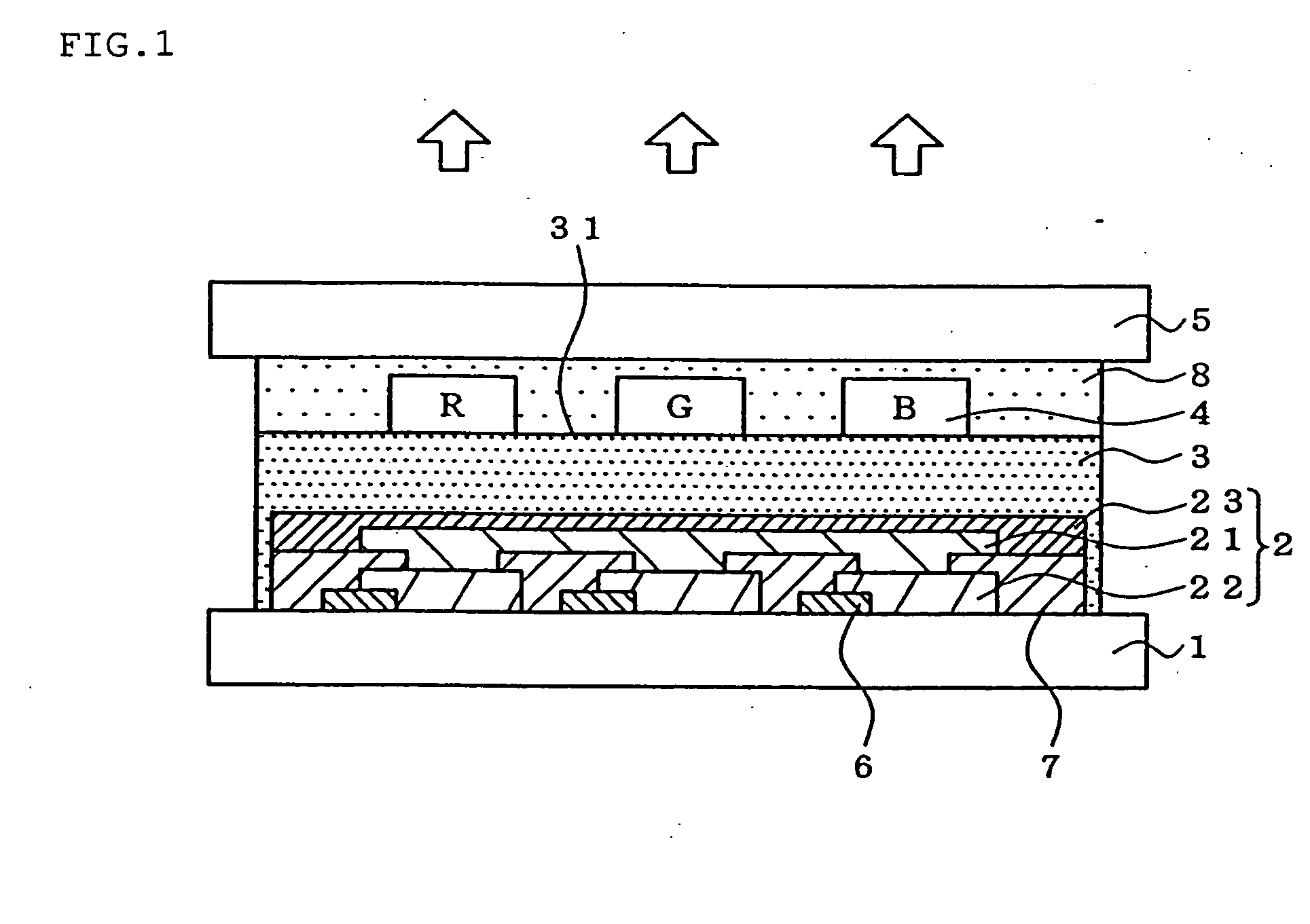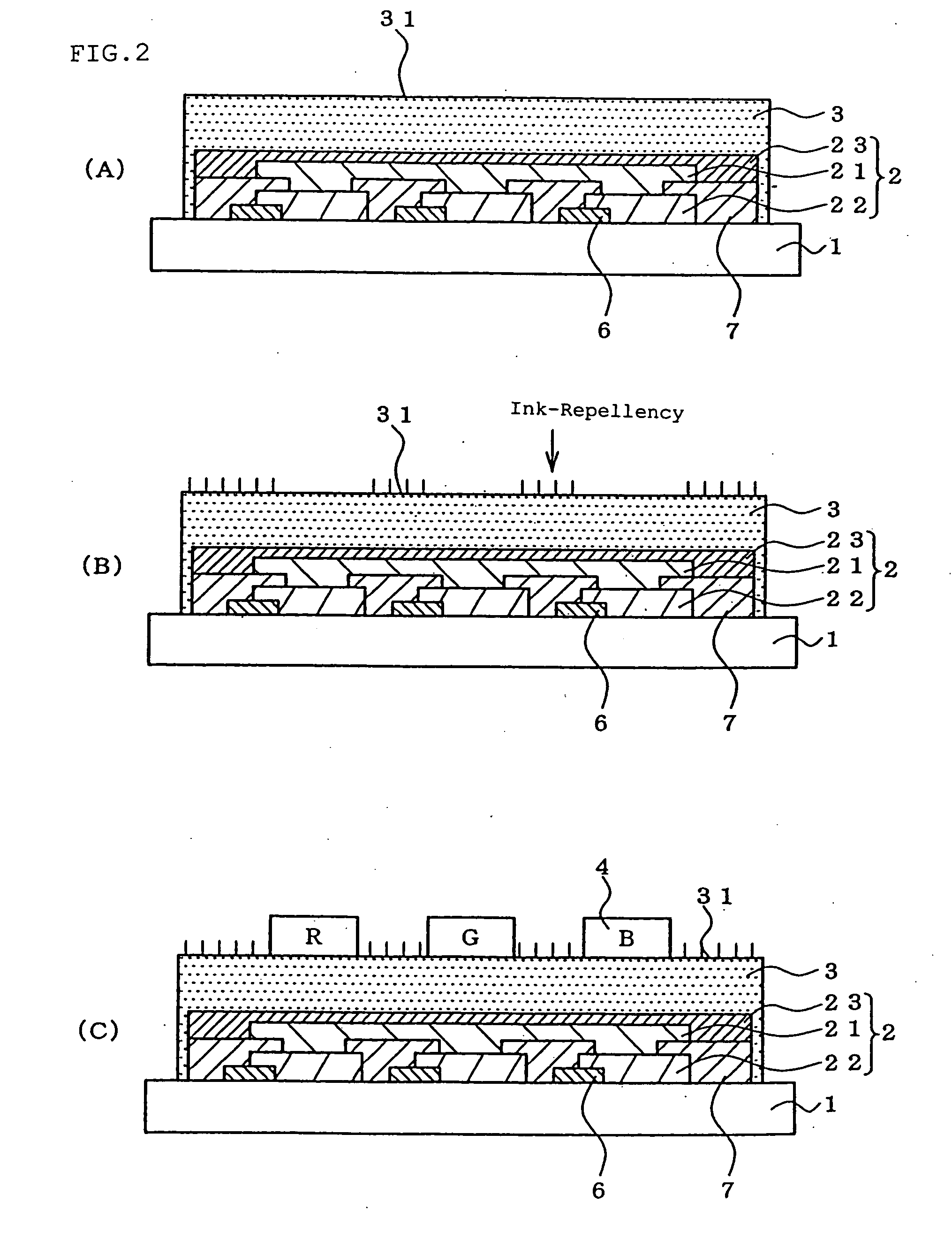Organic el display and its production method
a technology of electroluminescence and organic el, applied in the direction of discharge tube luminescnet screen, discharge tube/lamp details, organic semiconductor devices, etc., can solve the problems of difficult positioning and difficulty in increasing the opening ratio of pixels, and achieve excellent viewing angle properties and increase production yield
- Summary
- Abstract
- Description
- Claims
- Application Information
AI Technical Summary
Benefits of technology
Problems solved by technology
Method used
Image
Examples
first embodiment
[0065] Referring to the drawings, an organic EL display and its production method according to a first embodiment of the invention will be described hereinafter.
[0066]FIG. 1 is a diagram for explaining the structure of the organic EL display of the first embodiment.
[0067] As shown in this figure, in the organic EL display, TFTs 6 and under electrode 22 are formed on a supporting substrate 1, and an insulator 7, organic luminescent medium 21, upper electrode 23, sealing layer 3, coloring layer 4 and flattening layer 8 are laminated thereon in this order, a sealing substrate 5 being on the uppermost surface. The under electrode 22, organic luminescent medium 21 and upper electrode 23 constitute an organic EL device 2. Arrows show the direction in which light is taken out.
[0068] If a voltage is applied between the under and upper electrodes 22, 23, the organic luminescent medium 21 held by them emits light and the light passes via the sealing layer 3 to the coloring layer 4. The col...
second embodiment
[0085] An organic EL display and its production method according to a second embodiment of the invention will be described with reference to drawings.
[0086]FIG. 3 is a diagram for explaining the structure of the organic EL display of the second embodiment. The same members as the first embodiment are denoted by the same reference numerals and their detail explanation is omitted.
[0087] In this display, numeral 20 denotes an opening area and numeral 30 denotes a non-opening area. In only the opening area 20, an organic luminescent medium 21 emits light since the medium 21 is sandwiched between under and upper electrodes 22, 23. The light is taken out to the outside via a coloring layer 4. That is, light is taken out in the opening area 20 but light is not taken out in the non-opening area 30.
[0088] In the second embodiment, part of the surface 31 is not ink-repellent but concave parts 32 are formed in at least part of the opening area 20 on the top surface 31 of a sealing layer ins...
third embodiment
[0110] An organic EL display and its production method according to a third embodiment of the invention will be described with reference to drawings.
[0111]FIG. 5 is a diagram for explaining the structure of the organic EL display of the third embodiment. The same members as the first embodiment are denoted by the same reference numerals and their detail explanation is omitted.
[0112] In the third embodiment, part of the surface 31 of the sealing layer is not ink-repellent but an ink-receiving layer 10 is provided on a sealing layer 3 instead. Coloring layers 4 are provided at certain positions of the ink-receiving layer.
[0113] The ink-receiving layer is made of an ink-permeable resin and formed by printing, spin coating or applying. The layer has a thickness of about 0.5 μm to about 20 μm. Preferred resins include polyvinyl alcohols, celluloses and acrylate resins.
[0114] Next referring to FIG. 6, the method of producing the organic EL display according to the third embodiment wil...
PUM
 Login to View More
Login to View More Abstract
Description
Claims
Application Information
 Login to View More
Login to View More - R&D
- Intellectual Property
- Life Sciences
- Materials
- Tech Scout
- Unparalleled Data Quality
- Higher Quality Content
- 60% Fewer Hallucinations
Browse by: Latest US Patents, China's latest patents, Technical Efficacy Thesaurus, Application Domain, Technology Topic, Popular Technical Reports.
© 2025 PatSnap. All rights reserved.Legal|Privacy policy|Modern Slavery Act Transparency Statement|Sitemap|About US| Contact US: help@patsnap.com



